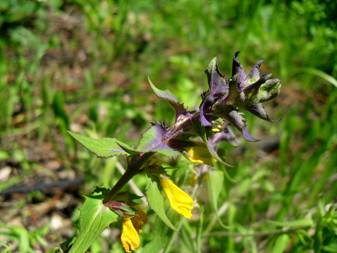

Wood Cow-wheat (Melampyrum nemorosum), fam. Scrophulariaceae.
An annual forest plant, which grows tall enough and bloom only from June. The yellow flowers, protruding out of the purple bracts, encouraged people for many legends. Such a contrast makes the plant very ornamental; but it should not be picked into bouquets, because the flowers fade very quickly.
Cow-wheat is a hemiparasite – it obtains part of its nutrition from the neighbor forest herbs and trees. Too luscious development of cow-wheat, which may form continuous thickets, sometimes displaces the host plants, then the hemiparasite dyes itself. The seeds ripen in autumn and sprout immediately, but its further development starts only in spring. The seeds are spread by the ants.
The plant is considered toxic; it decreases fodder qualities of herb mixtures for cattle, and may even cause animal poisoning. The infusions of the herb are used in small doses for stomach, heart diseases, hives, and externally for skin diseases.